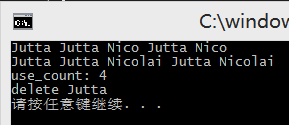本文将简要介绍智能指针shared_ptr和unique_ptr,并简单实现基于引用计数的智能指针。
使用智能指针的缘由
1. 考虑下边的简单代码:
1 int main() 2 { 3 int *ptr = new int(0); 4 return 0; 5 }
就如上边程序,我们有可能一不小心就忘了释放掉已不再使用的内存,从而导致资源泄漏(resoure leak,在这里也就是内存泄漏)。
2. 考虑另一简单代码:
1 int main() 2 { 3 int *ptr = new int(0); 4 delete ptr; 5 return 0; 6 }
我们可能会心想,这下程序应该没问题了?可实际上程序还是有问题。上边程序虽然最后释放了申请的内存,但ptr会变成空悬指针(dangling pointer,也就是野指针)。空悬指针不同于空指针(nullptr),它会指向“垃圾”内存,给程序带去诸多隐患(如我们无法用if语句来判断野指针)。
上述程序在我们释放完内存后要将ptr置为空,即:
1 ptr = nullptr;
除了上边考虑到的两个问题,上边程序还存在另一问题:如果内存申请不成功,new会抛出异常,而我们却什么都没有做!所以对这程序我们还得继续改进(也可用try...catch...):
1 #include <iostream> 2 using namespace std; 3 4 int main() 5 { 6 int *ptr = new(nothrow) int(0); 7 if(!ptr) 8 { 9 cout << "new fails." 10 return 0; 11 } 12 delete ptr; 13 ptr = nullptr; 14 return 0; 15 }
3. 考虑最后一简单代码:
1 #include <iostream> 2 using namespace std; 3 4 int main() 5 { 6 int *ptr = new(nothrow) int(0); 7 if(!ptr) 8 { 9 cout << "new fails." 10 return 0; 11 } 12 // 假定hasException函数原型是 bool hasException() 13 if (hasException()) 14 throw exception(); 15 16 delete ptr; 17 ptr = nullptr; 18 return 0; 19 }
当我们的程序运行到“if(hasException())”处且“hasException()”为真,那程序将会抛出一个异常,最终导致程序终止,而已申请的内存并没有释放掉。
当然,我们可以在“hasException()”为真时释放内存:
1 // 假定hasException函数原型是 bool hasException() 2 if (hasException()) 3 { 4 delete ptr; 5 ptr = nullptr; 6 throw exception(); 7 }
但,我们并不总会想到这么做。而且,这样子做也显得麻烦,不够人性化。
如果,我们使用智能指针,上边的问题我们都不用再考虑,因为它都已经帮我们考虑到了。
因此,我们使用智能指针的原因至少有以下三点:
1)智能指针能够帮助我们处理资源泄露问题;
2)它也能够帮我们处理空悬指针的问题;
3)它还能够帮我们处理比较隐晦的由异常造成的资源泄露。
智能指针
自C++11起,C++标准提供两大类型的智能指针:
1. Class shared_ptr实现共享式拥有(shared ownership)概念。多个智能指针可以指向相同对象,该对象和其相关资源会在“最后一个引用(reference)被销毁”时候释放。为了在结构复杂的情境中执行上述工作,标准库提供了weak_ptr、bad_weak_ptr和enable_shared_from_this等辅助类。
2. Class unique_ptr实现独占式拥有(exclusive ownership)或严格拥有(strict ownership)概念,保证同一时间内只有一个智能指针可以指向该对象。它对于避免资源泄露(resourece leak)——例如“以new创建对象后因为发生异常而忘记调用delete”——特别有用。
注:C++98中的Class auto_ptr在C++11中已不再建议使用。
shared_ptr
几乎每一个有分量的程序都需要“在相同时间的多处地点处理或使用对象”的能力。为此,我们必须在程序的多个地点指向(refer to)同一对象。虽然C++语言提供引用(reference)和指针(pointer),还是不够,因为我们往往必须确保当“指向对象”的最末一个引用被删除时该对象本身也被删除,毕竟对象被删除时析构函数可以要求某些操作,例如释放内存或归还资源等等。
所以我们需要“当对象再也不被使用时就被清理”的语义。Class shared_ptr提供了这样的共享式拥有语义。也就是说,多个shared_ptr可以共享(或说拥有)同一对象。对象的最末一个拥有者有责任销毁对象,并清理与该对象相关的所有资源。
shared_ptr的目标就是,在其所指向的对象不再被使用之后(而非之前),自动释放与对象相关的资源。
下边程序摘自《C++标准库(第二版)》5.2.1节:
1 #include <iostream> 2 #include <string> 3 #include <vector> 4 #include <memory> 5 using namespace std; 6 7 int main(void) 8 { 9 // two shared pointers representing two persons by their name 10 shared_ptr<string> pNico(new string("nico")); 11 shared_ptr<string> pJutta(new string("jutta"), 12 // deleter (a lambda function) 13 [](string *p) 14 { 15 cout << "delete " << *p << endl; 16 delete p; 17 } 18 ); 19 20 // capitalize person names 21 (*pNico)[0] = 'N'; 22 pJutta->replace(0, 1, "J"); 23 24 // put them multiple times in a container 25 vector<shared_ptr<string>> whoMadeCoffee; 26 whoMadeCoffee.push_back(pJutta); 27 whoMadeCoffee.push_back(pJutta); 28 whoMadeCoffee.push_back(pNico); 29 whoMadeCoffee.push_back(pJutta); 30 whoMadeCoffee.push_back(pNico); 31 32 // print all elements 33 for (auto ptr : whoMadeCoffee) 34 cout << *ptr << " "; 35 cout << endl; 36 37 // overwrite a name again 38 *pNico = "Nicolai"; 39 40 // print all elements 41 for (auto ptr : whoMadeCoffee) 42 cout << *ptr << " "; 43 cout << endl; 44 45 // print some internal data 46 cout << "use_count: " << whoMadeCoffee[0].use_count() << endl; 47 48 return 0; 49 }
程序运行结果如下:

关于程序逻辑可见下图:

关于程序的几点说明:
1)对智能指针pNico的拷贝是浅拷贝,所以当我们改变对象“Nico”的值为“Nicolai”时,指向它的指针都会指向新值。
2)指向对象“Jutta”的有四个指针:pJutta和pJutta的三份被安插到容器内的拷贝,所以上述程序输出的use_count为4。
4)shared_ptr本身提供默认内存释放器(default deleter),调用的是delete,不过只对“由new建立起来的单一对象”起作用。当然我们也可以自己定义内存释放器,就如上述程序。不过值得注意的是,默认内存释放器并不能释放数组内存空间,而是要我们自己提供内存释放器,如:
1 shared_ptr<int> pJutta2(new int[10], 2 // deleter (a lambda function) 3 [](int *p) 4 { 5 delete[] p; 6 } 7 );
或者使用为unique_ptr而提供的辅助函数作为内存释放器,其内调用delete[]:
1 shared_ptr<int> p(new int[10], default_delete<int[]>());
unique_ptr
unique_ptr是C++标准库自C++11起开始提供的类型。它是一种在异常发生时可帮助避免资源泄露的智能指针。一般而言,这个智能指针实现了独占式拥有概念,意味着它可确保一个对象和其相应资源同一时间只被一个指针拥有。一旦拥有者被销毁或变成空,或开始拥有另一个对象,先前拥有的那个对象就会被销毁,其任何相应资源也会被释放。
现在,本文最开头的程序就可以写成这样啦:
1 #include <memory> 2 using namespace std; 3 4 int main() 5 { 6 unique_ptr<int> ptr(new int(0)); 7 return 0; 8 }
智能指针简单实现
基于引用计数的智能指针可以简单实现如下(详细解释见程序中注释):
1 #include <iostream> 2 using namespace std; 3 4 template<class T> 5 class SmartPtr 6 { 7 public: 8 SmartPtr(T *p); 9 ~SmartPtr(); 10 SmartPtr(const SmartPtr<T> &orig); // 浅拷贝 11 SmartPtr<T>& operator=(const SmartPtr<T> &rhs); // 浅拷贝 12 private: 13 T *ptr; 14 // 将use_count声明成指针是为了方便对其的递增或递减操作 15 int *use_count; 16 }; 17 18 template<class T> 19 SmartPtr<T>::SmartPtr(T *p) : ptr(p) 20 { 21 try 22 { 23 use_count = new int(1); 24 } 25 catch (...) 26 { 27 delete ptr; 28 ptr = nullptr; 29 use_count = nullptr; 30 cout << "Allocate memory for use_count fails." << endl; 31 exit(1); 32 } 33 34 cout << "Constructor is called!" << endl; 35 } 36 37 template<class T> 38 SmartPtr<T>::~SmartPtr() 39 { 40 // 只在最后一个对象引用ptr时才释放内存 41 if (--(*use_count) == 0) 42 { 43 delete ptr; 44 delete use_count; 45 ptr = nullptr; 46 use_count = nullptr; 47 cout << "Destructor is called!" << endl; 48 } 49 } 50 51 template<class T> 52 SmartPtr<T>::SmartPtr(const SmartPtr<T> &orig) 53 { 54 ptr = orig.ptr; 55 use_count = orig.use_count; 56 ++(*use_count); 57 cout << "Copy constructor is called!" << endl; 58 } 59 60 // 重载等号函数不同于复制构造函数,即等号左边的对象可能已经指向某块内存。 61 // 这样,我们就得先判断左边对象指向的内存已经被引用的次数。如果次数为1, 62 // 表明我们可以释放这块内存;反之则不释放,由其他对象来释放。 63 template<class T> 64 SmartPtr<T>& SmartPtr<T>::operator=(const SmartPtr<T> &rhs) 65 { 66 // 《C++ primer》:“这个赋值操作符在减少左操作数的使用计数之前使rhs的使用计数加1, 67 // 从而防止自身赋值”而导致的提早释放内存 68 ++(*rhs.use_count); 69 70 // 将左操作数对象的使用计数减1,若该对象的使用计数减至0,则删除该对象 71 if (--(*use_count) == 0) 72 { 73 delete ptr; 74 delete use_count; 75 cout << "Left side object is deleted!" << endl; 76 } 77 78 ptr = rhs.ptr; 79 use_count = rhs.use_count; 80 81 cout << "Assignment operator overloaded is called!" << endl; 82 return *this; 83 }
测试程序如下:
1 #include <iostream> 2 #include "smartptr.h" 3 using namespace std; 4 5 int main() 6 { 7 // Test Constructor and Assignment Operator Overloaded 8 SmartPtr<int> p1(new int(0)); 9 p1 = p1; 10 // Test Copy Constructor 11 SmartPtr<int> p2(p1); 12 // Test Assignment Operator Overloaded 13 SmartPtr<int> p3(new int(1)); 14 p3 = p1; 15 16 return 0; 17 }
测试结果如下:

参考资料
《C++标准库(第二版)》